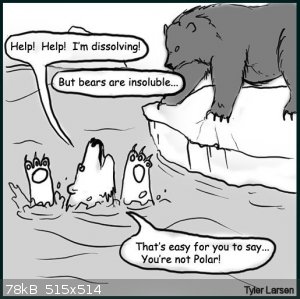Backyard Chemist
Harmless

Posts: 15
Registered: 28-12-2014
Member Is Offline
Mood: No Mood
|
|
Polar Bond Confusion!
Can the following compounds have a polar covalent bond?
1. AgCl
2. FeS
The electronegativities of these compounds are between 0.1 and 1.7, so therefore there would be a polar covalent bond? If so, how? If not, how?
|
|
|
Brain&Force
Hazard to Lanthanides
    
Posts: 1302
Registered: 13-11-2013
Location: UW-Madison
Member Is Offline
Mood: Incommensurately modulated
|
|
"Ionic" and "covalent" are a spectrum, there are no purely ionic bonds. You can only get purely covalent bonds between atoms with the same
electronegativity.
The bonds in this case have both ionic and covalent characteristics.
At the end of the day, simulating atoms doesn't beat working with the real things...
|
|
|
diddi
National Hazard
   
Posts: 723
Registered: 23-9-2014
Location: Victoria, Australia
Member Is Offline
Mood: Fluorescent
|
|
In the case of FeS, the compound displays typical transition metal to sulphide bonding which is highly covalent. very few of the transition metal
sulphides are soluble I water Many metal sulfides are often found in nature in that form (eg galena, pyrite, orpiment etc) demonstrating their
stability and lack of ionic bonding present. A number of the sulphides also form covalent lattice structures.
and from : https://answers.yahoo.com/question/index?qid=20100831204053A...
I have looked at this problem in detail before, and the result is quite surprising. I thought that a major contribution to the insolubility of AgCl
was that the solvation energy was much smaller than something like K^+ because Ag^+ is soft and water is hard, so the attraction of H2O for Ag^+ is
less than to the harder K^+. But this is not the case: the hydration energy of Ag^+ is as I recall comparable or slightly greater than the hydration
energies of the Group 1 metal cations.
It turns out that when you do the theoretical calculation of the lattice energies of the Group 1 halides (e.g., KCl) using the Born-Lande equation
the agreement with experimental (Born-Haber cycle) is remarkably good. However when you do the same procedure for AgCl (and AgBr, AgI) the
experimental lattice energy is as I recall some 150 kJ mol-1 higher than that calculated by the B-L eqn. In other words AgCl has an added energy
component that of course is attributed to partial covalent character. Besides the Coulombic attraction of Ag^+ ion for the Cl^- ion there is also some
sharing of electrons that further strengthens the lattice. A larger lattice energy means more energy to break up the lattice in the solvation process.
There is a delicate balance between U the lattice energy, and the ΔH(hyd) for M^+ and X^- for Group 1 halides; the ΔS term in ΔG also plays a major
role. For AgCl the larger U(AgCl) dominates and the stuff is completely insoluble. So AgCl is mainly ionic but with significant covalent character.
|
|
|
Bert
Super Administrator
        
Posts: 2821
Registered: 12-3-2004
Member Is Offline
Mood: " I think we are all going to die. I think that love is an illusion. We are flawed, my darling".
|
|

Rapopart’s Rules for critical commentary:
1. Attempt to re-express your target’s position so clearly, vividly and fairly that your target says: “Thanks, I wish I’d thought of putting it
that way.”
2. List any points of agreement (especially if they are not matters of general or widespread agreement).
3. Mention anything you have learned from your target.
4. Only then are you permitted to say so much as a word of rebuttal or criticism.
Anatol Rapoport was a Russian-born American mathematical psychologist (1911-2007).
|
|
|